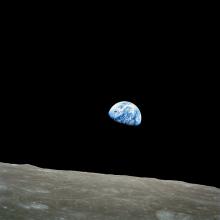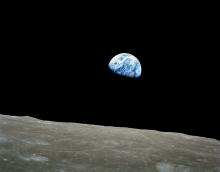Listen to today's episode of StarDate on the web the same day it airs in high-quality streaming audio without any extra ads or announcements. Choose a $8 one-month pass, or listen every day for a year for just $30.
You are here
Moon and Spica
A planet known as Theia may be the most important world you’ve never heard of. No one has ever seen it — and no one ever will. Yet we see its possible handiwork almost every day: the Moon. Current thinking says Theia slammed into Earth when our planet was still an infant. The impact blasted out material that soon came together to form the Moon.
Most scientists agree on that basic outline. But they’ve been debating the details for decades: the size of Theia, the fate of Theia itself, the timing of the Moon’s formation, and much more.
The original scenario said Theia probably was about the size of Mars — roughly half the diameter of Earth. A recent study, though, has suggested it could have been almost as big as Earth itself.
Models of what happened to Theia have been all over the place. Some recent ones suggest that its core joined with Earth’s, making Earth’s final core unusually big. In addition, parts of the mantle could have sunk into Earth’s mantle, forming big blobs of dense rock.
The Moon probably took shape fairly quickly — in as little as a few years. And one recent model said it could have happened in a matter of hours.
No matter how long it took, you can see the result tonight: the Moon. It has a bright companion: Spica, the brightest star of Virgo. It’s quite close to the lower right of the Moon — the possible creation of the most important planet you’ve never heard of.
Script by Damond Benningfield






